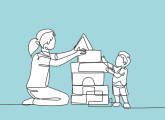Rageena Tahir and Olivia Jones share how to bring a language focus to your early years environment…
Babies are instinctively wired to learn language. From babbling to showing an understanding of what they hear, babies’ speech and language development quickly begins to emerge.
When children acquire strong language skills, this offers a gateway to most other forms of learning, as well as communicating their needs.
Speech and language skills open the door to a wealth of other skills including problem-solving, social and personal development, and emotional regulation. So, it’s important we provide the best possible learning environment to continuously enhance learning opportunities and support children to build these skills.
A language-rich environment promotes and encourages the enhancement of children’s communication and language development, taking into account both the physical and emotional environment, including positive and responsive interactions with adults.
Not only do children begin to develop their physical skills by exploring their environment through play; they are also forming imagination and language skills.
There are many ways you can bring a language focus to the forefront of the physical environment. Here are just a few:
Using open-ended resources in your setting and giving children time to play supports them to learn new words, engage in back-and-forth conversations with one another and use resources in a variety of ways, including problem-solving.
Loose parts play can include resources such as reels, acorns, rings, boxes, crates, planks, containers – anything that children can make into whatever they choose. With a little thinking and imagination, boxes can be turned into skyscrapers or race cars.
Using labels in your nursery is a great way to surround the physical environment with words. Seeing these labels every day helps children to memorise letter formation and understand the relationship between a word and its meaning.
Remember though, don’t go too overboard with the label maker as this could become overwhelming and more difficult for children to memorise.
You could also welcome children at your setting with some colourful self-registration cards. Self-registration is a great way to encourage children to recognise their name. This usually starts with their ability to recognise the first letter.
Try adding print to role play areas. For example, recipes with pictures will help children to comprehend the instructions and attribute meaning to the words, and real food packaging in home corners supports children in recognising familiar logos and brands that they may use at home.
The outdoors provides its very own classroom naturally primed for learning and exploring, with trees, plants, paths, levels and the ever-changing weather.
Supplementing this with further resources such as wheelbarrows, water channels, magnifying glasses and tools will encourage further exploration and the opportunity to introduce new concepts and vocabulary.
Through discussions and shared sustained thinking, children will develop confidence in communicating.
And of course, with outdoors being an extension of indoor learning, books and other print materials can be introduced to support learning.
An environment means more to a child than what’s physically around them. How they feel within that environment can influence their learning and development too.
It’s essential for a child to feel safe and secure in your setting. Creating a nurturing sense within your environment can also open up a wealth of opportunities for a language-rich environment.
Listen carefully to children, observe body language and what the child is doing, and respond appropriately.
This is the basis for secure, positive and supportive relationships between adults and the child. This relationship will in turn ensure that adults are providing warm and responsive interactions that support and coach children through understanding and managing their emotions – also known as co-regulation.
These types of interactions provide opportunities to introduce children to the language of emotions, helping them develop the ability to assign words to how they are feeling.
Create a quiet, cosy reading corner using cushions and soft rugs to support a relaxing emotional environment. Keep books at a level children can easily access so that older children can independently select which story they’d like to go and read.
Consider these points when making enhancements to your setting. Continuously reflecting on each of these areas and making improvements based on what you observe will help promote a language-rich environment.
Rageena Tahir is Head of EYFS and Olivia Jones is a content writer at Fennies Nurseries.

Emotional wellbeing – Why empathetic connection is key
Editors picks
